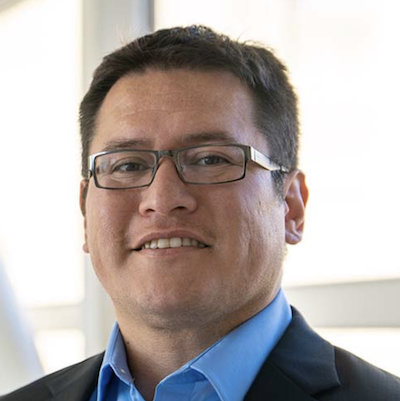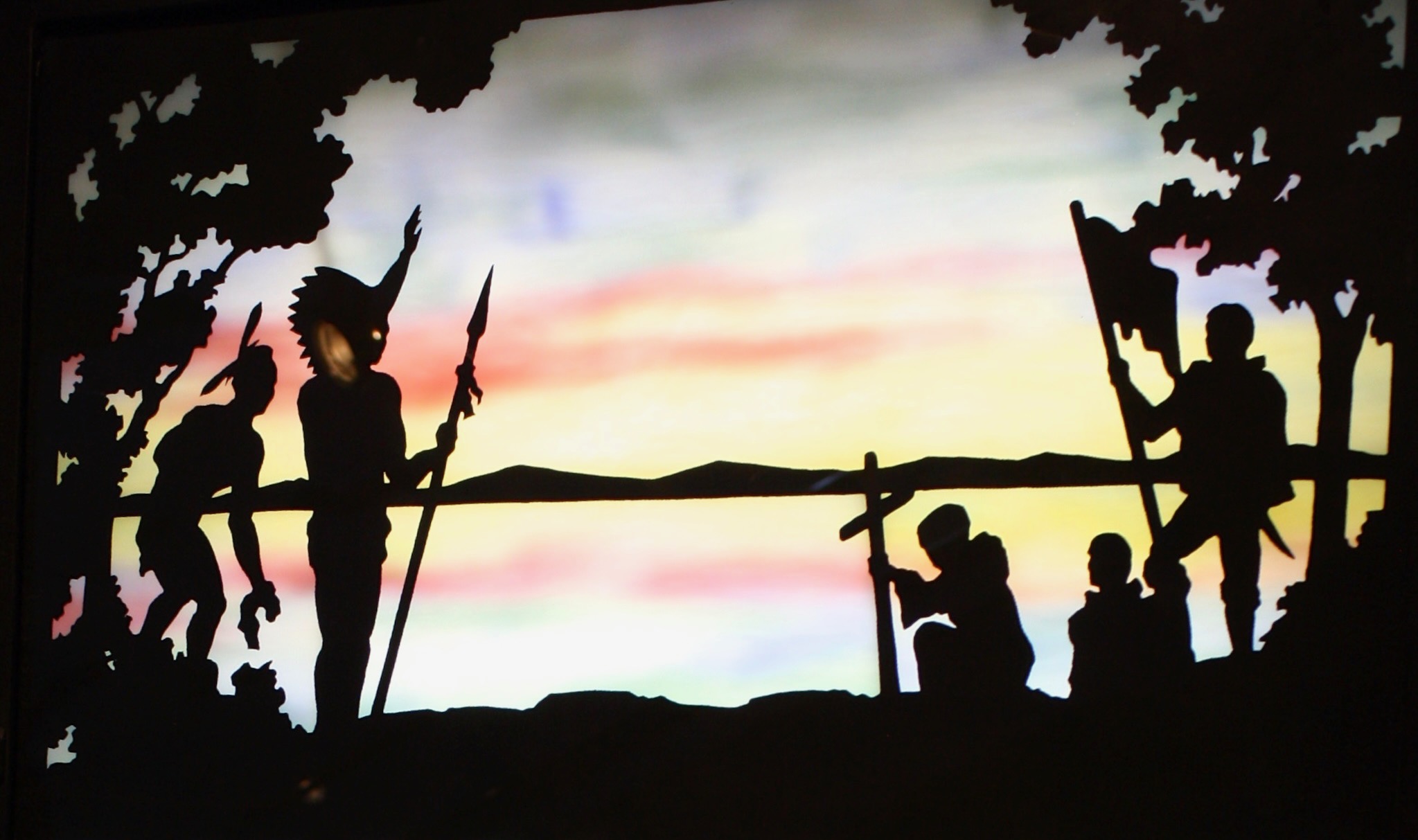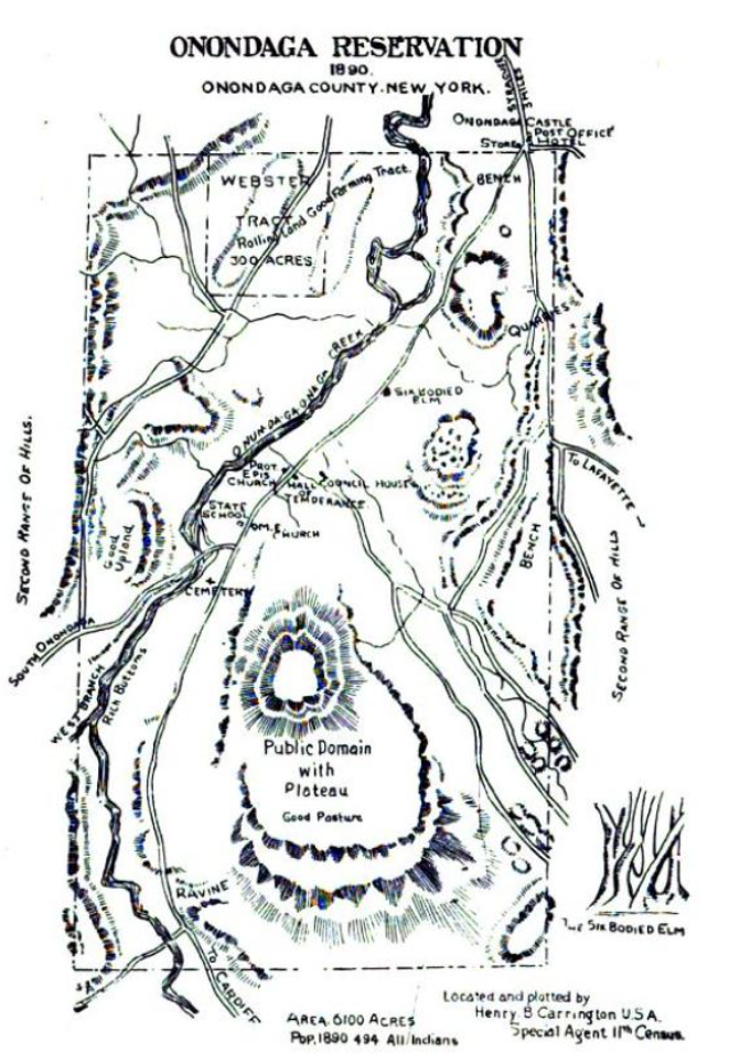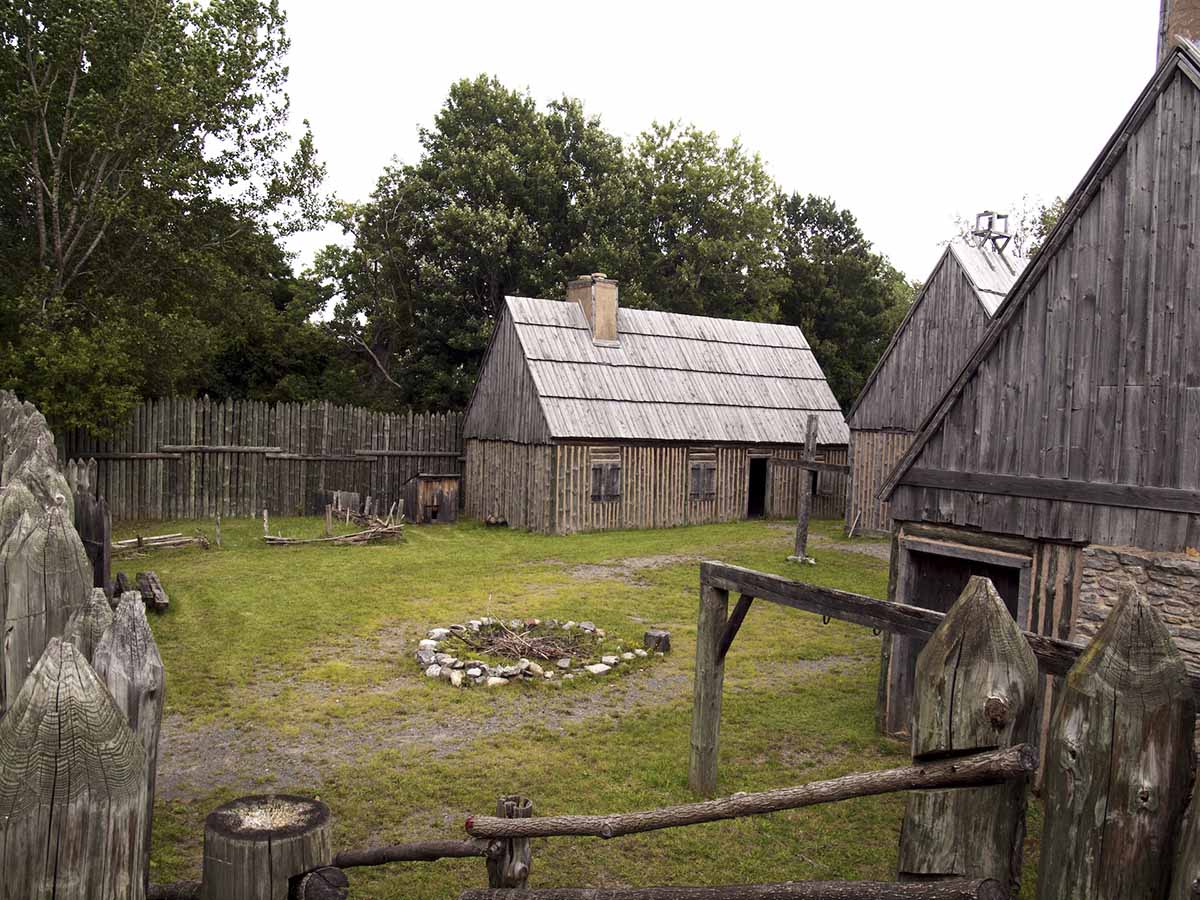Settler Colonialism in Higher Education: Syracuse University and the Legacy of the Doctrine of Discovery (… and Onondaga Limestone)
Keywords: Settler colonialism, higher education, land grant, the Whipple Report, Onondaga Nation, Syracuse University
IntroductionPermalink
In this article, I examine ways in which Syracuse University, a higher education institution located in Central New York, was founded from settler colonialism vis-à-vis the Doctrine of Discovery. I provide three historical moments in which campus leaders, legal constituents, and religious actors associated with the private interests of Syracuse University have enacted fraudulent treaty making, land theft, assimilation efforts, and forced religious conversion of Indigenous Peoples. The three key historical moments are as follows:
-
“Land Grab Beginnings”: Ezra Cornell donated to Genesee College of Lima (1865) after the college demanded for funds from The Morrill Act of 1862, which helped to secure the founding of Syracuse University, ensuring that the university benefitted from the seizure of Indigenous lands.
-
“The Campus on the Hill”: New York State interfered with federal treaty arrangements and in 1870 Judge Comstock acquired 50-acres of farmland to donate to Syracuse University, which moved campus to “the hill” just after its founding.
-
“The Onondaga Indian Problem”: Syracuse University’s third chancellor, Chancellor Charles Sims and his colleagues, attempted to coerce the Onondaga Nation through a fraudulent treaty (1883) to sell their lands to the state for the benefit of Syracuse University.
This paper shows how higher education institution were founded from settler colonialism. I situate Indigenous resiliency in this paper by showing how the Onondaga Nation navigated political tensions and economic sovereignty through use of valuable raw materials. I intentionally examine these historical instances through the lens of settler colonialism in higher education, which I define in the next section.
Defining “Settler Colonialism” in Higher EducationPermalink
Settler colonialism has shaped the education system throughout the world. In Decolonization is not a metaphor, Tuck and Yang (2012) describe settler colonialism as both external and internal modes—external, seizing for personal gain (e.g., forced removal of Indigenous peoples from homelands onto reservations for extraction of uranium and/ or oil) and internal, enacting control or maintenance (e.g., residential boardings schools). Tuck and Yang define settler colonialism as, settlers who arrive with “the intention of making a new home on the land, a homemaking that insists on settler sovereignty over all things in their new domain” (5). Yellow Bird (2020) provides that Indigenous scholars of higher education often define institutions of higher education as “colonial institutions” to mean institutions, situated on Indigenous lands, who provide an education from a White, Eurocentric framework. Higher education institutions fulfill both internal and external definitions of settler colonialism (Yellow Bird, 13). The following will explore ways in which Syracuse University enacted settler colonialism at its founding.
“The Shining City on the Hill”: The Doctrine of Discovery and Higher EducationPermalink
In 1452, a Papal Bull from Pope Nicholas V bestowed “special graces . . . to invade, search out, capture, vanquish, and subdue all Saracens and pagans whatsoever” (Mudimbe, 2005) all over the world initiated what is known as the Doctrine of Discovery, the “special graces” to steal Indigenous lands and subjugate Indigenous peoples. In 1493 Pope Alexander VI introduced “Inter Caetera” which validated Christian conquest over non-Christians all over the world including “the New World”, classifying Indigenous peoples among the “flora and fauna” and later as “sub-human” and so too, labelling Indigenous intellect as “savage” or “barbarous” (Adams, 1988). Christopher Columbus wrote in his diaries about his encounters with Indigenous Peoples (Taino) that they would be, according to Calloway (2016) “good and intelligent servants” who would “become Christians very easily, for it seemed to me that they had no religion” (p. 73).
In the short documentary, Pioneering the American Frontier (All Things Wild West, 2021, June) historian Howard Means describes that God had appointed settler the responsibility to claim Indigenous lands in the name of God. After describing ways US boundaries were established (taken), Means defines this further, that Christian settlers had an inherent right to the land,
the sense that God had ordained that the American people should fulfill their boundaries, basically Manifest Destiny, that it was America’s obligation as the shining city on the hill to claim this land. (6:15)
Centuries later, in 1823, the Doctrine of Discovery was adopted into US law through the Supreme Court in Johnson V. Mcintosh (1823).
The context of this paper is situated right before the Dawes Act (1887) or “the General Allotment Act” was signed into law, which authorized the federal government to allot or break up Tribal lands, sell them to American citizens, and encourage Native peoples to become US citizens. Higher education institutions at their founding were directly influenced by Termination Era policies, where Indigenous Peoples were disbanded from their homelands and their lands were bought and sold to benefit American citizens and racism about Indigenous Peoples surged.
“Land Grab Beginnings”Permalink
In the early 19th century, groups of economically disadvantaged populations were all too often excluded from higher education entirely— specifically farmers and blue-collar workers. In the late 1830’s a political movement swept through the United States, calling for the creation of agricultural colleges for the education of working-class people (Zimdahl, 2018). In 1857 the Morrill Act was proposed, passed in 1859, and the Morrill Land Grant College Act of 1862 was enacted. The act was passed the start of the residential boarding school era, to which the federal government sought lands to finance the founding of college and university campuses, which dispossessed Indigenous Peoples of almost one million acres of their lands (Anderson, 2022).
Cornell University1 was the largest beneficiary of the Morrill Act and received the most (about a tenth) of the total land granted to the founding and benefit of higher education institutions (O’Connell, 2020). After Cornell refused to be built on a hill in Syracuse, NY; Ezra Cornell sought out another city to found Cornell University in Ithaca, New York (approximately 50 miles south of Syracuse, NY). After confirmation that Cornell University would receive funding from the Morill Act, this stirred up considerable pushback from other schools and colleges. According to Halliday (1905), “denominational colleges tried to obtain a share of the proceeds and they succeeded in stirring up a religious sentiment against the act, on account of the proposed non - sectarian character of the new university” (p. 16).
Two colleges in direct opposition to Cornell University were the Peoples College and the Genessee College at Lima, the latter which would become Syracuse University. Halliday (1095) writes,
Far more unjust was the demand of Genesee College of Lima, a small denominational college which was afterward transferred to Syracuse and absorbed by Syracuse University. This institution insisted that it was entitled to a share in the land grant fund and demanded that $25,000 of that fund should be paid to it. (p. 17)
After Cornell had secured their founding as the primary university to be founded from Land Grant Funds, according to Halliday (1905), Ezra Cornell had paid “$25,000 to Genesee College… which showed that the requirements laid down in the charter had been complied with, and that Cornell University had become entitled to the proceeds from the land grant fund” (p. 19). After seeking Land Grant funding and being denied, Syracuse University was founded from Ezra Cornell’s contributions to Genesee College of Lima from his own money, in lieu of Genessee College’s requests and denial for Land Grant funding.
“The Campus on the Hill”Permalink
In 1870 the Methodist church held its state convention in Syracuse. During the convention a Methodist school located in Lima, NY passed a resolution towards the founding of a new university, “where Methodism had thrived for decades” (Syracuse.com). No doubt the school’s ability to charter a university was directly related to Ezra Cornell’s donation from the Morill Act, but there were several others who were interested in helping to fund such a university. Judge George Comstock of Syracuse was one such person, who offered the “the hill” on which Syracuse University now stands, which were then just 50 acres of farmland (1870) and he also donated $75,000, to contribute towards the establishment of Syracuse University. Not much is recorded about how Judge Comstock came to acquire that land.
According to Greene (2000), the first building built on campus was the Hall of Languages, which would become the “most recognizable building in the history of the university” (p. 4). On September 1, 1871, the cornerstone of the Hall of Languages had been laid, which was constructed out of Onondaga Limestone. Later, in May 1873, the Hall of Languages which was built “on a fifty-acre tract of land overlooking the city of Syracuse that had been donated to the University by George F. Comstock” (p. 4). At the cost of $136, 000, The Hall of Languages was built and dedicated in May 1873, built from the finest limestone in the state.
Attorney for the Onondaga Nation, Joe Heath, explains that Syracuse University’s founding and how they acquired the land is a mystery, but “how Onondaga lost it is simple: it was stolen” (para 3, Rivera, 2021). Of course, Joe Heath is referring to over 100 years prior, in which New York State illegally interfered with federal treaties to acquire lands from the Onondaga Nation and other Haudenosaunee nations through illegal deeds and treaties made with New York State officials (Graymont, 1976). New York State’s illegal dealings foreshadow much of the ways in which Syracuse University and its leadership attempted to completely undermine and eradicate the Onondaga people, which is discussed in the next section.
“The Onondaga Indian Problem”Permalink
The Indian Removal Policy was most favored by settler society, but while Indian land was being stolen, bought, then resold through the Allotment Act (or the Dawes Act, 1887), subsequently the “Indian problem” became much more prominent and politicized as land became available (Otis, 2014). Much of these attitudes about Indigenous Peoples were documented and well known.
The third chancellor of Syracuse University, Charles Sims, a Methodist preacher, served as chair of a committee of religious converts. Sims and his constituents participated in interviews conducted by a Chairman, James S. Whipple, called The Special Committee to Investigate the Indian Problem of New York State who eventually generated a large manuscript known as “The Whipple Report” to which the committee compiled interviews with the specific purpose to assimilate and divide Indigenous lands in New York State. Sims describes how he and his colleagues attempted to negotiate a “treaty” between New York State, Syracuse University and the Onondaga Nation. Interviews recorded in the Whipple Report (1889) reveal that in Sims and his associates, pushed for total assimilation of Onondaga children in order to divide Onondaga lands to benefit Syracuse University, an effort which ultimately failed. Later Sims mentions this fraudulent treaty in his own journal notes, now located in Syracuse University’s archives called, “The Onondaga Treaty” (1883). In the following subsections, I describe Chancellor Sims’ efforts to divide and privatize Indigenous lands and the state’s efforts to do the same, in the Whipple Report.
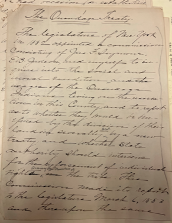
The Onondaga Treaty. Chancellor Sims describes the “treaty” which is now held in the Syracuse University archives, on the fifth floor of Bird Library. According to Sims’ notes, the New York State legislature appointed Sims and his colleagues to examine the “social and moral conditions and the usages of Onondaga Indians living on the reservation in this county” (Sims, 1883, p. 1). Sims continued, that on March 6, 1883, after making the report to the legislature, that he and his colleagues were commissioned to “negotiate a new treaty with the Onondaga nation looking to the division of lands in severally” (p. 2). Sims went on to describe the estimated size of the population on the Onondaga nation, treaties made with Onondaga between the state and federal governments, and his perceptions of their living conditions. He describes in length the “grotesqueness” of Onondaga nation residents, their “savage” ways, their drunkenness, and lack of civilization. Sims writes in depth about his disdain for Onondaga spiritual practices and gender dynamics which he notes that women are in charge of land acquisition, and what he refers to as “occupational possession” which is universally respected (p. 16). He writes about some “notable persons” of whom he is acquainted on the nation, but also his disagreements with marriage and lifestyle of what he refers to as the pagan religion. Finally, Sims describes his experiences with diplomacy and “ratifying” the treaty with the Onondaga. According to Sims (1883) record,
After many meetings and the experience of much diplomacy a treaty was agreed upon, subject to a vote of approval by the tribe and nine o’clock Thursday morning was appointed as the time for annexing the marks of the chiefs and the signatures of the commissioners. All parties had been warned to be promptly on time. The commissioners entered the chambers from promptly at nine o’clock. The chiefs were not there yet. Half-past nine, ten, eleven, half-past eleven came and yet no chiefs. Just as the commission was about to adjourn at twelve, the Indians began to straggle in. I said,
“Chief la Forte, why were you not here at nine o’clock as agreed upon, and why have you kept us waiting for so long?”
“O, that’s the Indian of it,” was his perfectly self-satisfied reply.
The treaty was finally signed and a day appointed for a the vote of ratification. Meantime a white man who had unlawfully leased a valuable place on the reservation went down and interviewed the voters, and when the ballot was cast, it was nearly unanimous against the treaty. It ended two years work of philanthropy and diplomacy in the interest of morals, religion, liberty, and good government in the nation of the Onondagas. (p. 30-31).
The philanthropic “treaty” negotiation effort led by Chancellor Sims was indeed a fraudulent treaty. Sims describes how the Onondaga leased out some of their lands to bring work and economic stability to the nation. A mysterious man intervened in the treaty that was led by Sims. The Whipple report details more about this mysterious man with interest in the quarries of the Onondagas.
The Whipple Report. A document titled, The Special Committee to Investigate the Indian Problem of New York State also known as “The Whipple Report” was designed to investigate the social, moral, and industrial condition of tribes or Indigenous nations in New York State. The special committee examined all treaties between each Indigenous nation and interviewed participants as to the conditions of each tribal nation to determine legislative action across the state. As documented in the Whipple Report, Charles Sims and Bishop Huntington,2 both of whom were Syracuse University leaders and affiliates, mention the condition of the Onondaga Nation. Sims co-founded a local group (“committee”) which consisted of many people in the Syracuse area including religious leaders, missionaries, judges, and politicians— and of course, individuals associated with Syracuse University— to convince people to address the customs of the Onondaga Nation and the ways in which Onondaga people conducted their lives. Their group called attention to their problem with Onondaga ceremonies, agriculture, schooling, child rearing, and their marriages. The following excerpt was taken from this interview conducted with Duncan in the report (1889),

Local politicians and people of power were constantly meeting about “what to do” about the Onondaga Nation, considering their interest in the land. It was clear that this local group (“committee”), co-chaired by Chancellor Sims, wanted to do something about the “Onondaga Indian Problem” (p. 1221) to which they made mention to a “treaty” with Onondaga. According to the Whipple Report (1889) on July 9, 1888, the committee interviewed Syracuse University Chancellor Charles Sims and Sims summed up what he thought should be done about the Onondaga people and their lands,
According to Chancellor Sims, Onondaga Nation lands needed to be sold off and Onondaga citizens needed to become citizens of the United States. But to the local committee’s dismay, Onondaga Nation citizens for the most part wanted nothing to do with the so-called treaty.
The non-Native man who leased the quarry on the south end from the Onondaga Nation paid members of the nation to mine what is known as “Onondaga limestone,” the same type of limestone which helped to build the Brooklyn Bridge, and Genesse County Courthouse, and The Hall of Languages at Syracuse University.
ConclusionPermalink
In this paper, I discussed several historical moments in which Syracuse University followed in the long dark legacy of settler “discovery.” After the Doctrine of Discovery was adopted into US law, Indigenous lands were thought to be fair game for most of the general American public, especially those in power positions in institutions of higher education. In 1862 the Morrill Land Grant College Act was passed through the Supreme Court which funded the founding land-grant-colleges, directly from the sales of federally “owned” lands obtained from seizure of Indigenous lands during the allotment era. In 1865, Cornell University donated $25,000 from Morrill grant aid, towards Syracuse University’s founding (this amount is worth approximately $500,000 today). In early 1870’s Judge Comstock offered Syracuse University a mysterious 50 acres of farmland on the hill. In 1870 Syracuse University was founded. In 1883 Chancellor Charles Sims created a fraudulent treaty, which Onondaga Chiefs voted unanimously against. In 1889 the Whipple Report was published about New York State’s years of efforts to completely seize all Indigenous lands in New York State, an effort which ultimately failed. Precious limestone in Onondaga quarries, later named “Onondaga Limestone” contributed to the production of salt in the City of Syracuse (Smith, 1904, p. 199). The limestone quarries offered the Onondaga Nation some level of economic advantage and political sovereignty during a period of Indigenous termination.
ReferencesPermalink
-
Adams, K. B. (1988). Order in the Courts: Resolution of Tribal/State Criminal Jurisdictional Disputes. Tulsa LJ, 24, 89.
-
All Things Wild West (2021, June). Pioneering The American Frontier - A documentary on The Oregon Trail. YouTube video. Retrieved: Pioneering The American Frontier - A documentary on The Oregon Trail - YouTube.
-
Anderson, K. (2022). Land Acknowledgments at Land-Grant Libraries and Archives: A Systematic Review. Journal of Western Archives, 13(1), 9.
-
Bird, E. Y. (2020). Settler colonial institutions of higher education: Indigenizations, generations & warriors (chasing butterflies) (Doctoral dissertation, The University of Arizona). Retrieved: Settler Colonial Institutions of Higher Education: Indigenizations, Generations & Warriors (Chasing Butterflies) - ProQuest.
-
Calloway, C. G. (2016). First peoples: A documentary survey of American Indian history. Bedford/St. Martin’s.
-
Graymont, B. (1976). New York State Indian Policy after the Revolution. New York History, 57(4), 438-474.
-
Greene, J. R. (2000). The Hill: An Illustrated Biography of Syracuse University, 1870-Present. Syracuse University Press.
-
Halliday, S. D. (1905). History of the Agricultural College Land Grant Act of July 2, 1862: Devoted Largely to the History of the” land Scrip” which Under that Grant was Allotted to the State of New York and Afterwards Given to Cornell University. Ithaca Democrat Press.
-
Mudimbe, V. Y. (2005). Romanus Pontifex (1454) and the expansion of Europe. Postcolonialisms: an anthology of cultural theory and criticism, 51.
-
O’Connell, S. (2020). Cornell’s Land Grant Heritage: A Sinister Tradition. The Cornell Daily Sun.
-
Otis, D. S. (2014). The Dawes Act and the allotment of Indian lands (Vol. 123). University of Oklahoma Press.
-
Rivera, A. R. (2021). It’s Not Our Hill. The News House. Retrieved: https://www.thenewshouse.com/divide/indigenous-inequality-hill-onondaga-activists/.
-
Sims, C. (1883). The Onondaga Treaty- Report of the Commission appointed by the State of New York 1883, Syracuse University Archives, Box 10, folder RG 01, Accessed: November 11, 2022.
-
Smith, C. E. (1904). Pioneer times in the Onondaga country (No. 281). CW Bardeen.
-
Syracuse.com. (2021, March). Looking back at Syracuse University’s founding and the creation of Orange basketball. Retrieved: Looking back at Syracuse University’s founding and the creation of Orange basketball - syracuse.com.
-
Tuck, E., Yang, K.W. (2012). Decolonization is not a metaphor. Decolonization: Indigeneity, education & society, vol. 1, no. 1, 2012, pp. 1-40.
-
Whipple, J. S. (1889). Report of Special Committee to Investigate the Indian Problem of the State of New York: Appointed by the Assembly of 1888. Transmitted to the Legislature February 1, 1889 (No. 51). Troy Press Company.
-
Zimdahl, R. L. (2003). The mission of land grant colleges of agriculture. American journal of alternative agriculture, 18(2), 103-115.
EndnotesPermalink
-
Cornell University sits on stolen Cayuga (Gayogo̱hó:nǫɁ) lands. The Cayuga Nation, a member of the Haudenosaunee Confederacy, lost over 1,200 acres of land after New York State violated the 1794 Canandaigua treaty. ↩
-
Present-day Syracuse University houses the School of Education in a building called “Huntington Hall,” named after Bishop Fredrick D. Huntington, a man who endorsed Christian conversion among the Onondaga people and whose participation in a local committee endorsed fraudulent treaty-making with the specific aim to divide the lands of the Onondaga Nation. ↩
SUGGESTED CITATION
Hugh Burnam, "Settler Colonialism in Higher Education: Syracuse University and the Legacy of the Doctrine of Discovery (... and Onondaga Limestone)," Doctrine of Discovery Project (1 February 2024), https://doctrineofdiscovery.org/blog/settler-colonialism-higher-education/.
Share on
X Facebook LinkedIn BlueskyDonate today!
Open Access educational resources cost money to produce. Please join the growing number of people supporting The Doctrine of Discovery so we can sustain this work. Please give today.

